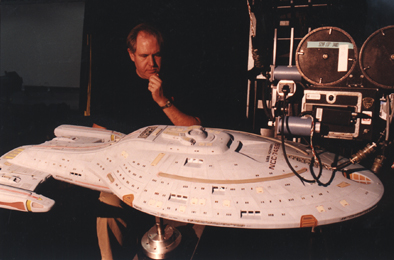-
Bio
Visual effects, science fiction and realms of the imagination are some of the driving forces that push me forward in my life. I began to feel this when I was about eleven or twelve years old. From the time I entered Jr high school I wanted to do something in film and visual effects. At that time there was almost no information available and the only film programs were at UCLA and USC colleges in Los Angeles.
Unable to afford universities, I attended community and state colleges as an art major. Even within my A.A. and B.A. degree art programs, I embraced motion picture visual effects as a medium to express my vision and creativity. This infuriated my art instructors to no end! My instructors wanted abstraction and free form multi-media expression while I insisted in working with traditional effects techniques.
I eventually graduated and I worked over the years as a stop motion animator, cell animator, model maker, matte painter, motion control programmer, cameraman, visual effects supervisor, and producer. I created visual effects for a number of science fiction television series including “Buck Rogers,” “Battlestar Galactica,” “The Flash,” and “Intruders.” I also operated my own studio for more than 12 years producing visual effects for such feature films as “Circuitry Man,” “Creepshow,” “Lawnmower Man,” and “Real Genius.”
I experienced the visual effects industry move from 19th century electro-mechanical technology, through computer controlled robotics and into computer generated imagery (CGI). I was unwilling to become obsolete, so I painfully moved from traditional effects into the growing field of digital effects.

It took me 25 years of preparation but I finally became an overnight success as a Visual Effects Supervisor on four Star Trek series: “The Next Generation,” “Voyager,” “Deep Space Nine,” and “Enterprise”. As effects capabilities improved, the demands of the story writers increased. I had no sooner joined Star Trek than I realized I could not deliver some of the scripted shots with the traditional techniques employed at that time.
Against some resistance, I championed the use of computer-generated imagery for Star Trek, which completely changed how the visual effects are created for the shows.
I moved to AZ in late 1999 to be closer to Nathan, my son, my church and friends. I have written articles on visual effects and production topics for “On-Location Magazine”, “Digital Studio Magazine,” “NewTekniques Magazine” and “Star Trek-The Magazine“. I am posting some of them on my website at www.davidstipes.com.
I taught for 19 years at The Art Institute of Phoenix and also at Scottsdale Community College. I am a Reiki III practitioner, and do a unique intuitive-art counseling service through Logos Center Church in Scottsdale, AZ.


Recent Comments